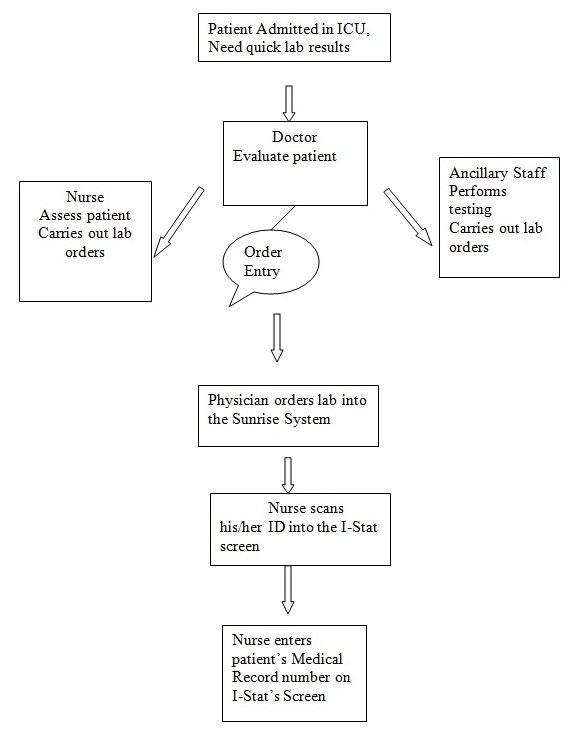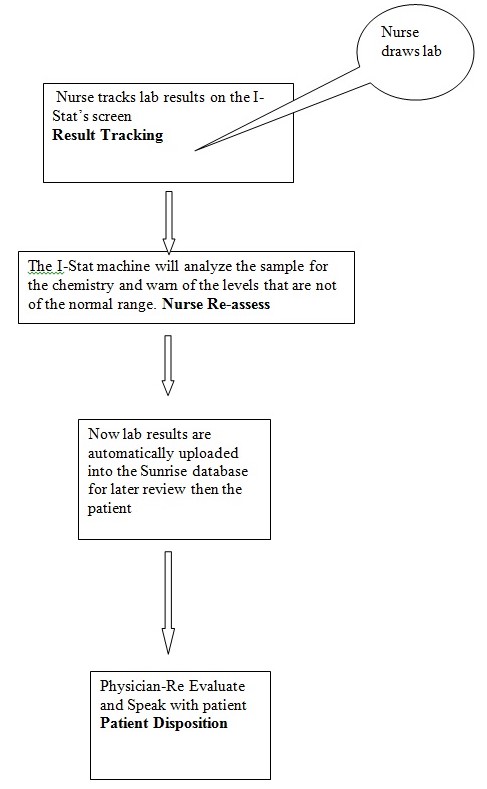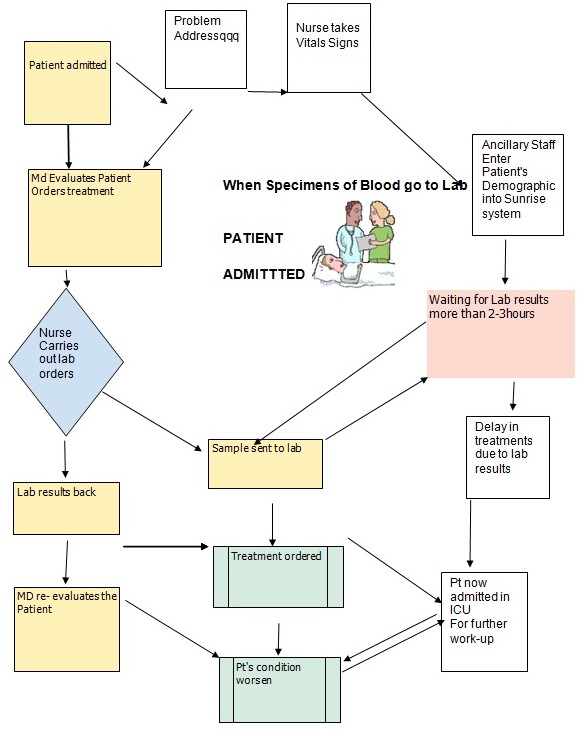Introduction
In the present –day health care environment, patients continue to attend emergency departments(ED) with diseases of increasing complexity and acuity. With reductions in the number of inpatient beds in many hospitals, the ED has become a place of significant bottlenecks in patient flow.
Not until the introduction and use of the I-stat hand held blood-analyzer that a host of challenges in the health care environment experienced a breakthrough. Evidently, the numbers of inpatient beds remained limited against the ever-increasing number of patients who attend the emergency (ED). This called for an innovative and urgent solution to address the problem.
The introduction of I-stat hand held blood analyzer incorporated in the i-stat system for use at the point of testing (PCOT) has revolutionized decisions making in cases where laboratory results form the basis for medical intervention, thus reducing the length of stay (LOS) for a patient. Health care professionals benefit from service delivery by making prompt decisions based on prompt results from the I-stat device. I-stat POCT is a timely communication diagnostic information approach for management to make decisions on patient treatment and care. This document takes an in-depth look at the introduction of POCT, its effectiveness in diagnosing patient medical condition, cost-effectiveness, its practicability, and the relative benefits derived by all stakeholders.
Abstract
Point –of-care hand held blood analyzers reduce the delay in 2/3 of cases for treatment of potentially life threatening abnormalities of blood chemistries. This paper will also discuss how PCBA enhanced and improved overall organization of the lab, improved patient’s care and decrease the patient’s length of stay.
Many problems plague the busy emergency department. This paper will make an in-depth examination of the problems plaguing the emergency department (ED), and examines how the implementation of the electronic tracking system and the i-stat hand held blood analyzer has influenced patient care by the timely use of information from the (POCT) in determining patient treatment and care (McGonigle, Dee, Kathleen, & Mastrian, 2009). It takes us through system functionality and illustrates how the system works to reduce the length of stay (LOS) which is among the benefits realized by heath professionals and patients. In addition, the paper provides an in-depth explanation on system implementation, the flow of data within the system, and the collaboration of different departments. The flow of data forms a fundamental part in patient medication, as accurate and reliable patient information is always readily available to influence decisions by the medical personnel.
Identification of Problem
Immediate results from patients attending the emergency department formed a fundamental tool in decision making by health professionals and other stakeholders. These results enable health professionals make timely decisions and look for the appropriate course of action. Timely communication of patient information, clear directions on the various departments, specific acquisition of information about the patient, accurate data, reduced waiting time, and reduced time for patient treatment included the host of problems identified when using the old white board method of attending to patient needs ( Fisne, & Joe, 2004). With these critical problems in mind, a team of heath professional and Information Technology experts set out to research and implement a computerized health system to address the problem area mentioned above. This brought the team to introduce i-stat computerized system that eventually caused a revolution on how patients underwent treatment with the use of i-stats hand held blood analyzer and system.
Background
PCBA devices have been used since late the 1980s, and most of ED, Long-term Critical Care, Flight Nurses, and Intensive Care Units are using them.
To help counter the challenges faced by patients who attended the emergency department (ED), it was vital to device ways of improving the capability of the health system in mitigating upon the challenges faced by health professionals, patients, and family members who had patients brought to the emergency department for treatment. In addition, according to information from The Cleveland Clinic (1995), “The Department of Nursing Informatics encourages nursing staff, patients and their families to suggest ideas for greater patient satisfaction”.
Problems plaguing the ED, translated to increased length of stay (LOS) in medical facilities particularly in the emergency departments and called into use the i-stat analyzer and system. Potter (2005) asserts that the main courses of concern revolved around time spent in the waiting room, time spent waiting for the doctor, examination time, and waiting for discharge, essentially translating to the length of stay (LOS). A bottleneck at any point in the system could adversely affect the quality and speed of the provision of such health services and particularly patient movement, records keeping, and their accuracy. Doctor Francois Saintfort asserts, “implementing innovative patient flow technology is critical for any facility looking to promote advances in healthcare” (StatCom, 2007). McGonigle et al., (2009) argues that Innovative, flexible, and dependable methods of resolving the problems plaguing the emergency department calls upon professional to conduct research on the efficiency of I-stat patient electronic system. The study indicated that technology coupled with the underlying structures, if efficiently used indicated a positive turnaround in speedy patient attention from the health staff. This called upon the team to sensitize the public using the whiteboard for “Without public display, providers have to sit down at a computer and check it, which can add time or reduce awareness (Science Daily, 2007). All must embrace technology. Boger (2003) has established that the outdated traditional white board system suffers from various disadvantages including inaccuracy of records, complication of patient flow, inability to generate patient information in a timely manner for management and health care staff to make decisions, and inaccurate inconsistencies that bedevil such records doubtlessly called into use of the i-stat analyzer and system. To avert such a scenario, Boger (2003) proposes that an electronic system could avert and resolve issues related to the whiteboard methodologies of patient administration. According to Potter (2005), the implementation strategy identifies staff participation in system development collaborating with IT professionals for the i-stat electronic system where the i-stat blood analyzer is integrated. To obtain data from patients, medical staff, and other stakeholders, interviews were an instrumental tool to that end. Then an analysis of data conducted to determine the best course of action. Potter (2005) emphasizes on the use of tracking board, asserting that its design incorporated basic elements while its configuration was kept as simple as possible.
According to the paper, Design of Patient Tracking tools May have Unlimited Consequences (2007), the implementation procedure involved defining a timeline and the establishment of a policy of smooth transition from the old system to the new system. In addition, intense consultations with project team members went on. Diagrammatic presentation of Information played a key role in illustrating how the new system’s implementation worked. With clear illustrations on the functionalities of the i-stat hand held blood analyzer, every team member remained well versed with its operations. Manuals formed a fundamental element of training with provisions made to all project team members. It was a requirement that every team member be properly versed with the functionalities of the new device besides to contribute positively on its introduction and use. Hannah et al., (2006) asserts that training of staff members had to be based on the needs of each discipline and be carried out separately to address the unique needs in each department. Add to these, each disciplines’ needs were clearly identified.
Assessment
These devices are worthwhile in emergency settings. It is worth the money and Point-of-care understands the need for fast, accurate, and reliable results that give health care professionals the confidence they need to make appropriate decisions. It provides real-time lab-quality results. This resulted from a study conducted at Cape Regional hospital.
An assessment on the way patients were attended to in an hospital in Cape Regional Medical center, their experiences, and expectations coupled with the opinions of the staff, made the team deem it viable to proceed with the implementation plan. Worthy to mention, at the facility, it came to the attention of the project team that medical staff had serious shortcoming in finding patient records, tracking patient movement, inaccurate patient records, lack of and inappropriate information for medical staff to make decisions, and the use of White board with all its inefficiencies. Add to these, the i-stat hand held blood analyzer coupled with the electronic system could play a vital role in curbing the aforementioned problems. These problems justified the use of the i-stat hand held blood analyzer integrated in an electronic system.
Statement of proposal
Our staff was very reluctant initially when we introduced this new device. One of the vendors presented its product demonstration to our staff and physician and nursing assistants. We selected one vendor called Abbot. In addition, a team formed with the sole responsibility of investigating the functionality of the proposed system by evaluating on the outcome from its use and recommending to the relevant management on the way forward was multidisciplinary. The team comprised clerical staff, IT experts, system administrators, ED technicians, nurses, and physicians. Staff had to participate in the implementation of the new plan, and actively contribute to new innovative ideas about the system. In addition, the medical staff, it was recommended that a strategic plan be put in place to test other vendor products and analyze them to determine the ones that came with a favorable price and of good quality. Price comparisons, quality, durability the ease of availability, and implementation were factors recommended. Ethically, the source and method of manufacture were recommended as influencing factors in evaluating the vendors of the i-stat hand held blood analyzer.
Implementation/discussion
With a single-use cartridge that measures different panels of chemistries, we evaluated the analytical performance of I-Stat. The introduction of the i-stat blood analyzer presented challenges to the management team in its implementation. A clear implementation strategy was proposed and agreed upon after consultations with the management and the team members. A proposal was made to administration to create the position of a greeter responsible for entering patient data and complaints into the system on arrival in the ED while the informatics nurse who could oversee the operation of the computer system in the Emergency Department. Upon entering the Emergency department, the patient’s information collected and appropriately entered into the computer system and thereafter the patient admitted in the intensive care unit (ICU). Immediate Laboratory results could be important for the doctor to evaluate and recommend the treatment to be administered on the patient. It is worthy noting that the time for lab results remained considerably reduced.
Data to populate the system comes from diverse sources. The patient provides personal information, family members may also provide further information about the patient, and nurses carrying out the i-stat test. The system consists of computer interfaces that allow nurses to enter information about the patient with ease into the electronic system. The human computer interface is tailor made to suit a health environment, thus, the interaction between the computer and health professionals is quite convenient.
As illustrated on the diagram below, nurses track lab results on the i-stat system through computer screens installed at various points in the health system.
As illustrated on the diagram below, upon admission in the ED, the nurses collect information and carry out lab orders. In addition, auxiliary staff performs testing on the patient’s lab samples by carrying out lab orders. Once the tests have been performed through the i-stat analyzer, a warning from the i-stat system informs of the chemical levels of and automatically uploads the results into the sunrise database for later review. This may include a physician speaking with the patient disposition. The movement of data in the i-stat system is worthy noting. Raw data is vital in making decisions about the current medical condition of a patient. From the flow chart illustrated below, a patient’s data flows promptly from the hand held blood analyzer as soon as a case was encountered. This implies that data may not necessarily be obtained at the hospital level but anywhere an emergency case occurred.
Notably, patient information may be refined depending on the diagnosis of the doctor and alternative prescriptions. Information entered into the sunrise database may provide further treatment history of the patient. In addition, it could be kept for a long time, as the vendor technology was a state of the art technology. Real time generation of patient reports was realized. However, the technology provided access rights and levels for privacy and confidentiality purposes.
As illustrated on the diagram at the back of the paper, there are two fold ways of entering the ED. The route for walk-in incorporates entering the ED, registering by providing vital personal information, and entering the waiting bay. After these, the treating technician attends the patient. The triangle nurse collects the patient’s demographic information.
The flow of data and functionalities as illustrated by the direction of the arrows as indicated on the diagram at the back of the paper. These diagrams illustrate how data moves from the patient to the sunrise database for future use. In addition, for a detailed presentation of how nurses handle the collection, use, and flow of data, the diagram at the back of the paper provides a detailed view of the use of the i-stat system.
To implement the project, the team created diagrams depicting processes in the emergency and fast track areas. The diagrams illustrated on how patients enter the ED area, depending on their medical conditions. Some diagrams illustrated walk-ins, while others depicted ambulances.
Plan for Evaluation
Our facility’s data shows that patient’s length of stay and treatments has decreased and patient satisfaction has been noted in most of ED. This was based on the type of data the team decided to use. Collecting data manually was a herculean task. This done, a timeline was decided on the implementation and evaluation of the system. Customized screens were used to meet the relevant user’s needs, and diagrams formed an important part in addressing patient issues such as direction. In addition, the use of diagrams depicting functionality of the i-stat hand held blood analyzer formed a vital point of analysis. Diagrams clearly illustrated the use of the new device and formed a part of the training manual in the work place. Further, diagrammatic representation of the flow of data within the departments, patient location, and use of initials to hide patient identity played a key role the department’s integrity. Noteworthy are the benefits that come with the use of the i-stat hand held blood analyzer. Patients could tremendously benefit from the i-stat hand held blood analyzer. Medical staff too could benefit as it transform the manner in which important data about a patient could be obtained to elicit immediate action by the physicians leading to reduced loss of life and efficiency in the utilization of medical staff and resources.
Gradually, staff comprising Nurses, Physicians, Ancillary, ED technicians and others underwent training on the use of the new system.
Summary
Our staff experienced some difficulties first, and then these problems were resolved with multiple use and more in-services were provided on the site. Our facility has reported better performance and increased staff satisfaction. The productivity has also been increased in critical care units. Challenges surfaced at the implementation level were later resolved with the aid of IT professionals who formed part of the team. Upon the introduction and implementation of the system, there was noted significant rise in productivity. In addition, the problem of change over to the new system was resolved after staff gradually accepted it to be part of their tools at the work place. Problems inherent with the white Board, such as lack of patient information, slow retrieval of patient history, inaccurate records regarding patients, and complicated patient flow were resolved. In addition, the implementation of the system after implementation affords illustration as on the back of the document for comparative analysis.
The tables at the back of the paper illustrates the findings from various departments and patients on the efficiency of the systems and clearly illustrate the degree of acceptability of the i-stat hand held blood analyzers and the i-stat electronic system integrated together. The correlation of data underwent an analysis for making future decisions. The data, statistically analyzed showed high correlated, implying high efficiency and reliability. However, further tests were done to verify and validate the data.
Table for the level of difficulty of use of the i-stat hand held blood analyzer.
Table illustrating correlation of the values on the difficulty and ease of the i-stat hand held blood analyzer:
Drawing an Inference on the above data indicates highly correlated data. This statistical inference on a normal curve indicates a value in the range of +.05 on the normal curve within a 95% confidence interval. This validates the results on the importance and benefits accruing from the use of i-stat blood analyzer and the hypothesis of implementing the use of the i-stat blood analyzer. This device could doubtlessly cause a revolution in the medical field.
References
Boger, E. RN (2003), Electronic tracking board reduces ED patient length of stay at Indiana hospital. Journal of Emergency Nursing
Fisne, J. (2004) ER Tracking System Prevents “Lost’ Patients-Community
Hannah, Kathryn, Ball, J., Marion, J., Edwards, & Margaret J.A (2006). Introduction to nursing informatics. New York, NY: Springer Science +Business Media
McGonigle, Dee, K., & Mastrian (2009). Nursing Informatics and the Foundation of Knowledge. Jones and Bartlett, 2009.
Potter, M. BSN, RN (2005). The Tracking Board. Innovations in Advanced Practice
Science daily (2007), Design of Patient Tracking Tools May have Unlimited consequences. Web.
StatCom (2007), Hospitals are in transitioning from manual patient flow methods to advanced flow logistics systems. Web.
The Cleveland Clinic (1995), Nursing Informatics. Web.
Flow diagram indicating the movement of the patient after tests with the i-stat machine has been done.



Flow chart on use of i-stat hand held blood analyzer:
